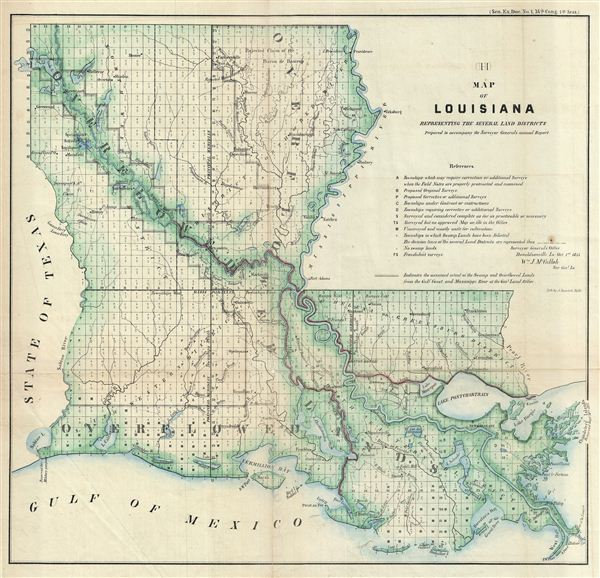This item has been sold, but you can get on the Waitlist to be notified if another example becomes available, or purchase a digital scan.
1855 Public Survey Map of Louisiana
Louisiana-publicsurvey-1855
Title
1855 (dated) 16 x 17 in (40.64 x 43.18 cm)
Description
In the northeastern part of the state the 'rejected Claims of the Baron de Bastrop' are identified. Bastrop was a curious, nefarious, and dynamic individual who, though largely unknown in history books, played a significant role in this history of America, particularly Texas. Bostrop was born Philip Hendrick Nering Bogel in Dutch Guiana but relocated to Holland as a young map where, with his parents, he settles I Leeuwarden, Friesland. Reaching his maturity, Philip took a post as tax collector for the province. In 1793 he was rightfully prosecuted for stealing the provincial taxes for personal gain. Just one step ahead of the headsman, Philip, now traveling under the assumed name of Felipe enrique Neri, fled to Spanish Louisiana. There through sheer force of charisma he convinced the local settlers that he was a Dutch nobleman fleeing the French invasion of Holland. He fabricated the title 'Baron de Bastrop' and negotiated with the Spanish governor to take control of much of northwestern Louisiana and southern Kentucky in order to found a colony in the Ouachita River Valley. When Louisiana joined the United States Bastrop's claims in this region were rejected and the colony put on hold for lack of funds. Looking for new opportunities he moved to the then Mexican Texas. A chance acquaintance with Moses Austin several years earlier led to Bastrop lobbying successfully for the establishment of the Ango-American Austin colony in Texas. These events later led to the Mexican American War and the annexation of Texas.
This map was engraved by A. Hoen and Company, government printers, in Baltimore, Maryland for issue in the 1856 congressional report, Maps and Views to Accompany Message and Documents 1855-56.
CartographerS
The General Land Office (1812 - 1946) was an independent agency charged with the administration and sale of public lands of the western territories of the United States under the Preemption Act of 1841 and the Homestead Act of 1862. During a time of frenetic energy and rapid westward expansion, the Land Office oversaw the surveying, platting, mapping and eventually the sale of much of the Western United States and Florida. The structural layout of the western United States that we see today, and many of their district and county divisions, are direct result of the early surveying work of the General Land Office. More importantly, as a branch of the Federal Government in Washington D.C. and the only agency able to legally sell and administer public lands in the western territories of the United States, the General Land Office played a pivotal role in consolidating power away from the original states and into the hands of the centralized federal government. The General Land Office was absorbed into the Department of Interior in 1849 and in 1946 merged with the United States Grazing Service to become the Bureau of Land Management. Today the Bureau of Land Management administers the roughly 246 million acres of public land remaining under federal ownership. More by this mapmaker...
August Hoen and Company (fl. c. 1840 - 1981) was a Baltimore based engraving and lithography firm active in the middle part of the 19th century. A. Hoen and Co. was originally founded by Edward Weber under the name 'E. Weber and Company.' Weber died in the early 1850s and his company was taken over by German immigrant August Hoen (18?? - 1886) and his brothers, Henry and Ernest Hoen. As general interest lithographers, the Hoen firm's corpus includes posters, cigar boxes, sheet music covers, and posters as well as maps. They are best known for their pioneering multi-color lithographic techniques. After the death of August Hoen, the business passed on to his son, Albert Hoen. Another son, Earnest A. Hoen, moved to Richmond, Virginia and opened a branch of the firm there where he was granted a charter to produce Civil War era Confederate Currency. Their contributions to the cartographic field are generally in association with engraving and printing work done for Jacob Monk and the U.S. Geological Survey. The Hoen family maintained an active interest in the firm for the next 100 years or so until it finally filed for bankruptcy in 1981. Learn More...

